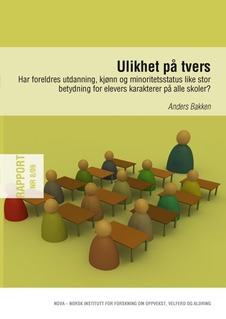| dc.description.abstract | This is the first report from NOVAs contribution to the ongoing evaluation of the Knowledge Promotion reform, initiated by the Ministry of Education and Research and organised and financed by the The Norwegian Directorate for Education and Training. The project - Does the Knowledge Promotion reform also promote equality in achievement? - aims at investigation whether the reform reduces inequalities in achievement based on parental education, gender and minority status in lower secondary school. A general idea is that schools may have something to learn from each other. Thus, the intention of the project is to identify schools where parental education, gender and minority status have divergent impact on pupils' marks and investigate what are the characteristics of these schools. This will partly be approached by quantitative analyses of pupil achievement data and measures describing schools, and partly by case studies of selected schools where the impact of parental education, gender and minority status is particularly large or small. The project lasts until 2011. In this first report we utilize data from pupils in lower secondary school before the reform was implemented. The aim of the report is to contribute to the ongoing question of what potential schools have to reduce inequalities in school achievement based on parental education, gender and minority status. The research question is two-folded. First, we ask whether the SES-gradient and the gender and minority achievement gaps are equally or differently distributed through the school system. It is assumed that small variations between schools suggests that achievement gaps are something very general and not much affected by schools. In opposite, larger variations may indicate that the sources of the gaps are within-school practice. Second, we ask whether a strong school culture for learning raises the achievement level for all groups of students at the same rate, or whether some groups are more affected than others. It is assumed that traditionally underperforming students, such as lower SES, boys and minority students, are more vulnerable to the learning environment and the quality of education than higher SES, girls and majority students. Thus, it is expected that the low achieving groups are more dependent of a well developed learning environment in school. For this analyses we employ matched achievement and social background data of all students who completed compulsory education in Norway (10th grade in the lower secondary school) in the years 2005 to 2007. These students were the last three cohorts leaving lower secondary before the Knowledge Promotion reform started. The dataset contains information about more than 180.000 pupils and their parents from 1.200 schools nationwide. In addition, we use data from the Pupil Survey in 2005 and 2006 to measure how pupil evaluate their own learning environment. For each school three achievement gaps are measured, one for the SES-gradient, one for the gender gap and one for the minority gap. In addition, we calculate a value added achievement measure and a learning environment measure as indicators of how well each school has embedded a learning culture. A major finding is that achievement gaps at the national level to a large degree are found at the school level. This is particularly the case for the SES-gradient, but less stringent for the gender and minority gaps. The results suggest that for many schools the main source of the achievement gaps is not within-school practice. At the same time, there are a significant number of schools that deviate from the general pattern, where achievement gaps are either smaller or larger than what is commonly found. An optimistic result is that schools that scores well on the value added achievement measure and where students evaluate their learning environment in particularly positive ways also have smaller SES-gradient and gendergap.Thissuggeststhat boys and students with lower socioeconomic background benefit of attending schools that in general succeed by achieving the learning goals. On the other hand, the impact does not seem to be very large and there is not a positive relation at the school level between school quality and equity for minority students. | en |
